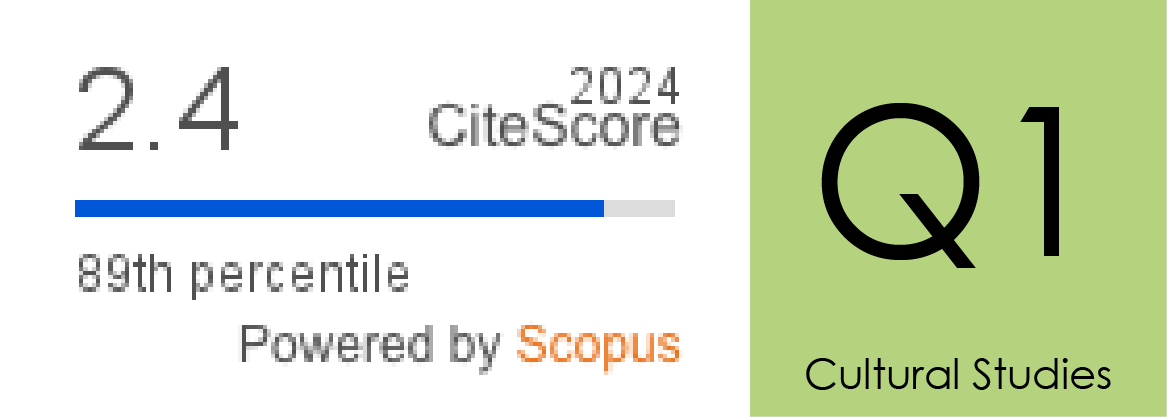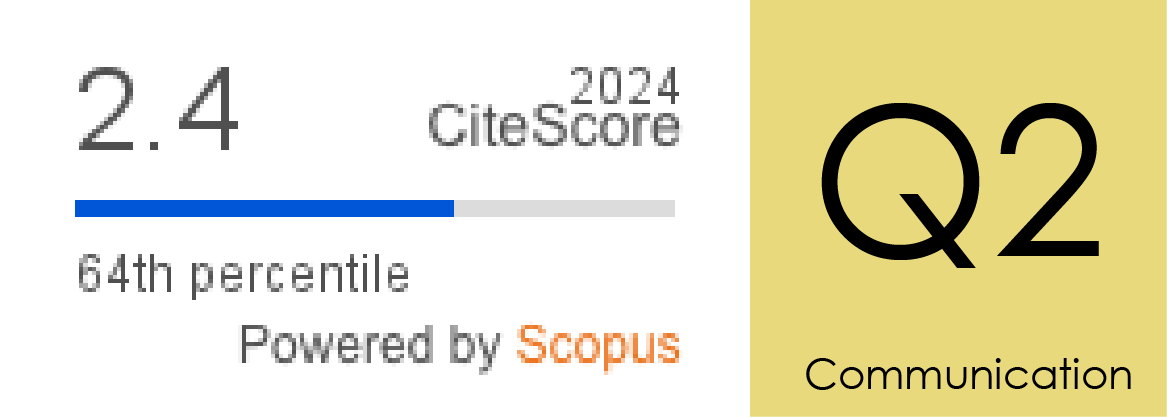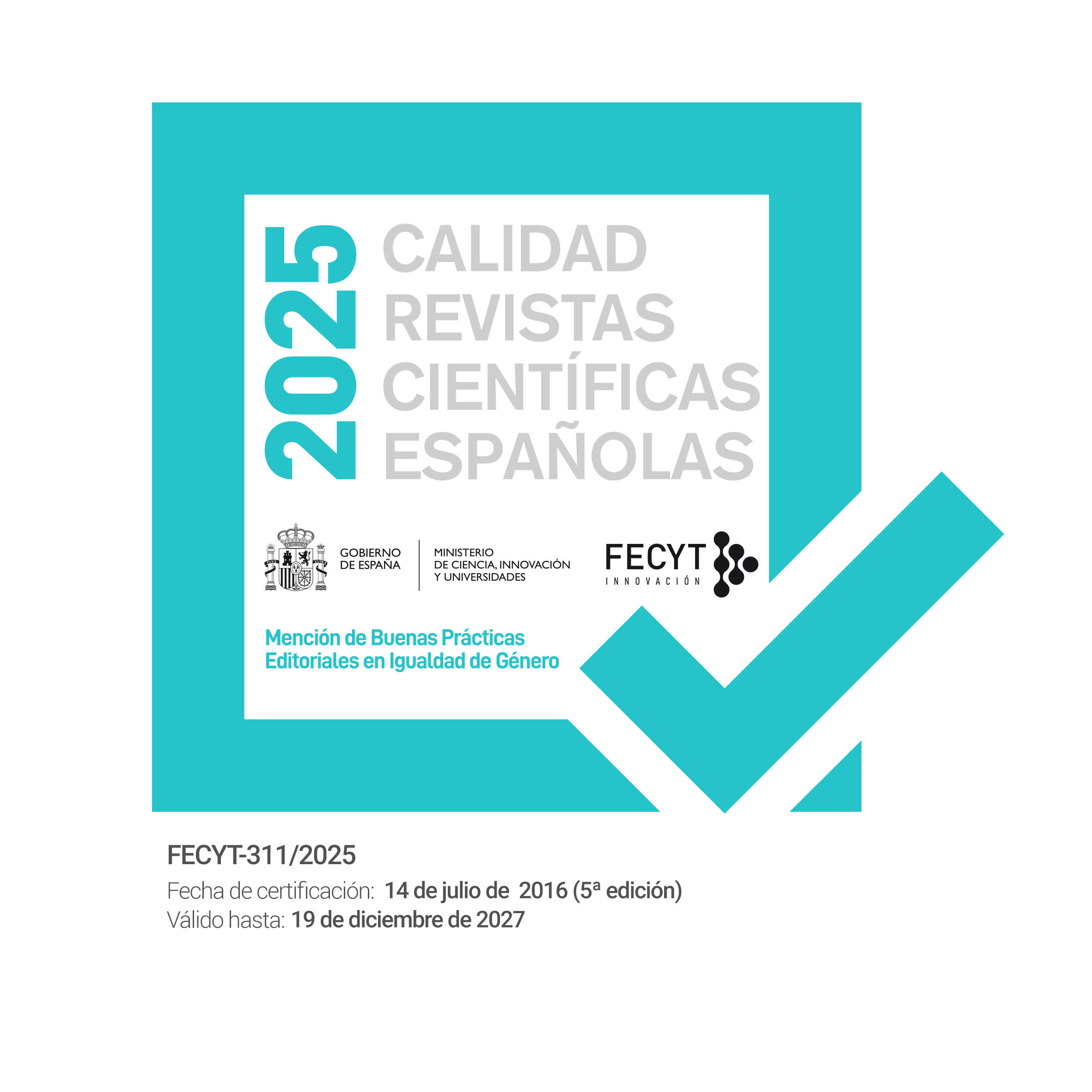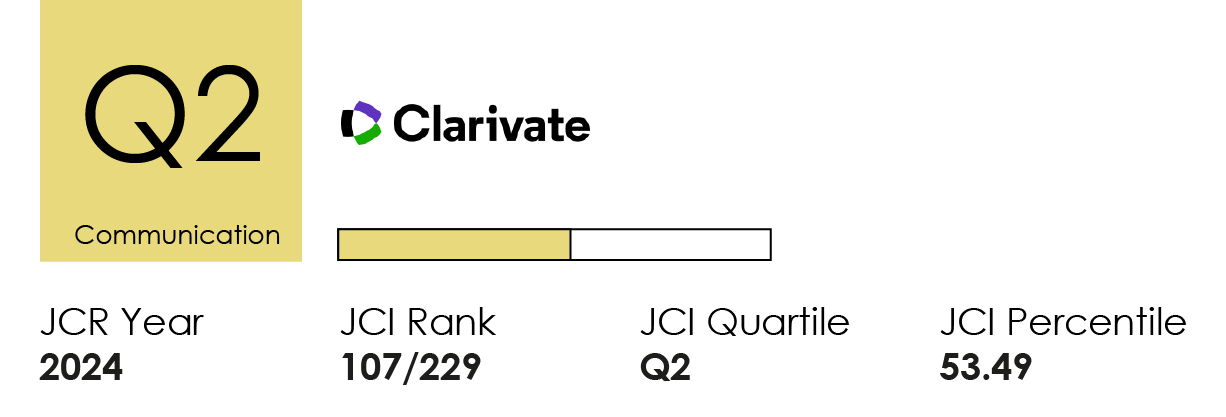La gestión de la reputación online en las asociaciones españolas de enfermos de cáncer: una propuesta de modelo
DOI:
https://doi.org/10.14198/MEDCOM.22240Palabras clave:
Asociaciones de Pacientes de Cancer, Comunicación Corporativa, Marca, Reputación, Redes SocialesResumen
Las asociaciones de enfermos de cáncer se han convertido en un verdadero actor de salud pública ya que ayudan a los pacientes a afrontar esta enfermedad desde un punto de vista físico, emocional y social. Algunas de estas asociaciones recurren a las redes sociales para mejorar sus relaciones con los pacientes, así como para promocionar su propia marca. Este artículo tiene como objetivo comprender cómo las asociaciones españolas de pacientes con cáncer gestionan sus redes sociales para promover su marca. Para ello, realizamos una revisión de literatura sobre comunicación en salud; recurrimos a 48 indicadores para analizar cómo las 107 asociaciones pertenecientes al Grupo Español de Enfermos de Cáncer (Gepac) gestionaban Facebook, Twitter, Youtube y su web corporativa para promocionar su marca; y finalmente proponemos un modelo de comunicación para ayudar a dichas asociaciones a promocionar su marca en las redes sociales (Modelo MedPac). Concluimos que las asociaciones españolas de enfermos de cáncer priorizan la información médica pero no la arquitectura de marca, carecen de los recursos económicos y humanos necesarios para producir contenidos de calidad, y no implementan un verdadero enfoque de comunicación corporativa.
Citas
Abramson, K., Keefe, B., & Chou, W. (2015). Communicating About Cancer Through Facebook: A Qualitative Analysis of a Breast Cancer Awareness Page. Journal of Health Communication, 20(2), 237-243. https://doi.org/10.1080/10810730.2014.927034
Ali, M. G. A. (2022). A General Perspective about Institutional Rankings, Ranking Framework, Benefits of Rankings and Ranking Methodological Flaws and Best Approach for Being A World Class Institution. International Journal of Educational Research Review, 7(3), 157-164. https://doi.org/10.24331/ijere.1067952
Alkibay, S., Ozdogan, B., & Ermec, A. (2007). Corporate Visual Identity: A Case in Hospitals. Health Marketing Quarterly, 24(3-4), 131-149. https://doi.org/10.1080/07359680802125204
Almodóvar, R., Gratacós, J., & Zarco, P. (2018). Information Needs of Patients With Spondyloarthritis About Their Disease. Reumatología Clínica, 14(6), 367-371. https://doi.org/10.1016/j.reuma.2017.02.004
Antheunis, M., Tates, K., & Nieboer, T. (2013). Patients’ and health professionals’ use of social media in healthcare: motives, barriers and expectations. Patient Education and Counselling, 92, 426-431. https://doi.org/10.1016/j.pec.2013.06.020
Archiopoli, A., Ginossar, T., Wilcox, B., Avila, M., Hillm, R., & Oetzel, J. (2016). Factors of Interpersonal Communication and Behavioral Health on Medication Self-Efficacy and Medication Adherence. AIDS Care, 28(12), 1607-1614. https://doi.org/10.1080/09540121.2016.1192577
Attai, D., Sedrak, M., Katz, M., Thompson, M., Anderson, P., Kesselheim, J., & Fisch, M. (2016). Social Media in Cancer Care: Highlights, Challenges & Opportunities. Future Oncology, 12(13). https://doi.org/10.2217/fon-2016-0065
Badr, H., Carmack, C., & Diefenbach, M. (2015). Psychosocial Interventions for Patients and Caregivers in the Age of New Communication Technologies: Opportunities and Challenges in Cancer Care. Journal of Health Communication, 20(3), 328-342. https://doi.org/10.1080/10810730.2014.965369
Balasooriya-Smeekens, C., Walter F., & Scott, S. (2015). The Role of Emotions in Time to Presentation for Symptoms Suggestive of Cancer: a Systematic Literature Review of Quantitative Studies. Psychooncology, 24(12), 1594-1604. https://doi.org/10.1002/pon.3833
Basch, C., Basch, C., Hillyer, G., & Reeves, R. (2015). YouTube Videos Related to Skin Cancer: A Missed Opportunity for Cancer Prevention and Control. JMIR Cancer, 1(1). https://doi.org/10.2196/cancer.4204
Becerra, E., Reina, J., y Victoria, J. (2015). Comunicación e imagen de los servicios sanitarios. El caso de los centros hospitalarios andaluces (2004-2013). Prisma Social. Revista de Ciencias Sociales, 14, 1-28.
Blomgren, M., Hedmo, T., & Waks, C. (2016). Being Special in an Ordinary Way: Swedish Hospitals’ Strategic Web Communication. International Journal of Strategic Communication, 10(3),177-194. https://doi.org/10.1080/1553118X.2016.1176569
Brent, R. (2016). Communication Theory and Health Communication Practice: The More Things Change, the More They Stay the Same. Health Communication, 31(1), 1-11. https://doi.org/10.1080/10410236.2014.923086
Busto-Salinas, L. (2021). ¿A más prestaciones sanitarias mayor presencia y actividad en redes sociales? Estudio comparativo entre hospitales de Colombia y España. Communication & Society, 34(1), 93-108. https://doi.org/10.15581/003.34.1.93-108
Cady, S., Wheeler, J., DeWolf, J., & Brodke, M. (2011). Mission, vision and values: what do they say? Organizational Development Journal, 29(1), 63-78.
Costa-Sánchez, C., & Míguez-González, M. (2018). Use of Social Media for Health Education and Corporate Communication of Hospitals. El Profesional de la Información, 27(5), 1145-1150. https://doi.org/10.3145/epi.2018.sep.18
Costa-Sánchez, C., Túñez-López, M., y Videla-Rodríguez, J. J. (2016). Hospitales españoles en la web social. Gestión de Facebook y Twitter por el Hospital Sant Joan de Dèu (Barcelona). Revista latina de comunicación social, 71, 1108-1130. https://doi.org/10.4185/RLCS-2016-1137
De Vries, A., Gholamrezaee, M., Verdonck-de Leeuw, I., de Roten, Y., Despland, J., Stiefel, F., & Passchier, J. (2018). Physicians' Emotion Regulation during Communication With Advanced Cancer Patients. Psychooncology, 27(3), 929-936. https://doi.org/10.1002/pon.4614
Esparcia, A. C., Villafranca, P. L., y Carretón-Ballester, M. C. (2015). La comunicación en la red de pacientes con enfermedades raras en España. Revista Latina de Comunicación Social, 70, 673-688. http://dx.doi.org/10.4185/RLCS-2015-1065
Esposito, A. (2017). Hospital Branding in Italy: A Pilot Study based on the Case Method. Health Marketing Quarterly, 34(1), 35-47. https://doi.org/10.1080/07359683.2016.1275211
Statista. (2021). Number of monthly active Facebook users worldwide as of 4th quarter 2021(in millions). Statista. https://bit.ly/3LRnfrH
Fernández-Gómez, E., y Díaz-Campo, J. (2016). Comunicación sobre el cáncer en Facebook: Las asociaciones de Argentina, Chile, Colombia y España. Cuadernos.info, 38, 35-50. https://dx.doi.org/10.7764/cdi.38.926
Fischer, S. (2014). Hospital Positioning and Integrated Hospital Marketing Communications: State-of-the-Art Review, Conceptual Framework, and Research Agenda. Journal of Nonprofit & Public Sector Marketing, 26(1), 1-34. https://doi.org/10.1080/10495142.2014.870431
Foro Español de Pacientes. (2021). Organizaciones miembro. Foro Español de Pacientes. https://bit.ly/3MUY9si
Gilligan, C., James, E., Snow, P., Outram, S., Ward, B., Powell, M., Lonsdale, C., Cushing, A., Silverman, J., Regan, T., Harvey, P., & Lynagh, M. (2016). Interventions for Improving Medical Students’ Interpersonal Communication in Medical Consultations. Cochrane Database of Systematic Reviews, 2. https://doi.org/10.1002/14651858.CD012418.pub2
Hannawa, A., García-Jiménez, L., Candrian, C., Rossmann, C., & Schulz, P. (2015). Identifying the Field of Health Communication. Journal of Health Communication, 20(5), 521-530. https://doi.org/10.1080/10810730.2014.999891
Househ, M., Borycki, E., & Kushniruk, A. (2014). Empowering Patients through Social Media: The Benefits and Challenges. Health Informatics Journal, 20(1), 50-58. https://doi.org/10.1177/1460458213476969
Huesch, M., Currid-Halkett, E., & Doctor, J. (2014). Public Hospital Quality Report Awareness: Evidence from National and Californian Internet Searches and Social Media Mentions, 2012. BMJ Open, 4(3). https://doi.org/10.1136/bmjopen-2013-004417
Jahromi, V., Tatabaee, S., Abdar, Z., & Rajabi, M. (2016). Active listening: The Key of Successful Communication in Hospital Managers. Electronic Physician, 8(3). https://doi.org/10.19082/2123
Janz, N., Li, Y., Zikmund-Fisher, B., Jagsi, R., Kurian, A., An, L., McLeod, M., Lee, K., Katz, S., & Hawley, S. (2016). The Impact of Doctor-Patient Communication on Patients' Perceptions of their risk of Breast Cancer Recurrence. Breast Cancer Research and Treatment, 161(3), 525-535. https://doi.org/10.1007/s10549-016-4076-5
Jones, C., Jensen, J., Scherr, C., Brown, N., Christy, K., & Weaver, J. (2015). The Health Belief Model as an Explanatory Framework in Communication Research: Exploring Parallel, Serial, and Moderated Mediation. Health Communication, 30(6), 566-576. https://doi.org/10.1080/10410236.2013.873363
Kemp, E., Jillapalli, R., & Becerra, E. (2014). Healthcare Branding: Developing Emotionally Based Consumer Brand Relationships. Journal of Services Marketing, 28(2), 126–137. http://dx.doi.org/10.1108/JSM-08-2012-0157
Kotsenas, A., Aase, L., Arce, M., & Timimi, F. (2018). The Social Media DNA of Mayo Clinic – and Health Care. Journal of American College of Radiology, 15, 162-166. https://doi.org/10.1016/j.jacr.2017.09.026
Lagu, T., Goff, S., Craft, B., Calcasola, S., Benjamin, E., Priya, A., & Lindenauer, P. (2016). Can Social Media Be Used as a Hospital Quality Improvement Tool? Journal of Hospital Medicine, 11(1), 52-55. https://doi.org/10.1002/jhm.2486
Lim, W. (2016). Social Media in Medical and Health Care: Opportunities and Challenges. Marketing Intelligence & Planning, 34(7), 964 – 976. http://dx.doi.org/10.1108/MIP-06-2015-0120
Liu, X., Guo, X., Wu, H., & Vogel, D. (2014). Doctor’s Effort Influence on Online Reputation and Popularity. In X. Zheng, D. Zeng, H. Chen, Y. Zhang, C. Xing, & D. B. Neill (Eds.), International Conference on Smart Health (pp. 111-126).
López-Navarrete, A., Cabrera-Méndez, M., Díez-Somavilla, R., y Calduch-Losa, Á. (2021). Fórmula para medir el engagement del espectador en YouTube: investigación exploratoria sobre los principales youtubers españoles. Revista Mediterránea de Comunicación, 12(2), 143-156. https://doi.org/10.14198/MEDCOM000013
Maier, C. (2016). Beyond Branding: Van Riel and Fombrun’s Corporate Communication Theory in the Human Services Sector. Qualitative Research Reports in Communication, 17(1), 27-35. https://doi.org/10.1080/17459435.2015.1088892
Matarín Jiménez, T. (2015). Redes sociales en prevención y promoción de la salud. Una revision de la actualidad. Revista Española de Comunicación de Salud, 6(1), 62-69.
Medina Aguerrebere, P. (2020). Twitter’s Impact in Building Reputed Hospital Brands in USA. Revista OBS, 14(4). https://doi.org/10.15847/obsOBS14420201531
Medina Aguerrebere, P., González Pacanowski, T., & Medina, E. (2020). Promoting Pharmaceutical Companies’ Reputation through Facebook: the Case of Spain. Harvard Deusto Business Research, 9(2), 243-254. https://doi.org/10.48132/hdbr.306
Miller, C., Guidry, J., & Fuemmeler, B. (2019). Breast Cancer Voices on Pinterest: Raising Awareness or Just an Inspirational Image? Health Education and Behaviour, 46(2S), 49-58. https://doi.org/10.1177/1090198119863774
Moore, P., Rivera, S., Bravo-Soto, G., Olivares, C., & Lawrie, T. (2018). Communication skills training for healthcare professionals working with people who have cancer. Cochrane Database System Review, 24(7). https://doi.org/10.1002/14651858.CD003751.pub4
Myrick, J., Holton, A., Himboim, I., & Love, B. (2016). Stupidcancer: Exploring a Typology of Social Support and the Role of Emotional Expression in a Social Media Community. Health Communication, 31(5), 596-605. http://dx.doi.org/10.1080/10410236.2014.981664
Namkoong, K., Nah, S., Record, R., & Van Stee, S. (2017). Communication, Reasoning, and Planned Behaviors: Unveiling the Effect of Interactive Communication in an Anti-Smoking Social Media Campaign. Health Communication, 32(1), 41-50. http://dx.doi.org/10.1080/10410236.2015.1099501
Park, H., Reber, B., & Chon, M. (2016). Tweeting as Health Communication: Health Organizations’ Use of Twitter for Health Promotion and Public Engagement. Journal of Health Communication, 21(2), 188-198. https://doi.org/10.1080/10810730.2015.105843
Pelitti, P. (2016). Estrategias de comunicación interna y externa de los hospitales públicos bonaerenses de la Región Sanitaria X. Question. Revista especializada en comunicación y periodismo, 1(49), 368-379.
Prochaska, J., Coughlin, S., & Lyons, E. (2017). Social Media and Mobile Technology for Cancer Prevention and Treatment. American Society of Clinical Oncology Educational Book, 37, 128-137. https://doi.org/10.14694/EDBK_173841
Rando Cueto, D., y de las Heras Pedrosa, C. (2016). Análisis de la comunicación corporativa de los hospitales andaluces vía twitter. Opción, 32(8), 557-576.
Rodrigues, A., Azevedo, C., & Calvo, V. (2016). Internal Communication In Organizations: Practical Instruments to Help the Shift Change. Millenium, 2(1), 105-114. https://doi.org/10.29352/mill0201.09.00004
Ruiz-Granja, M. (2015). Análisis comunicacional de páginas web hospitalarias. El caso de los hospitales sevillanos. Revista Española de Comunicación y Salud, 6(2),138-156.
Sánchez Fierro, J. (2019). Transparencia y democracia participativa en el Sistema Nacional de Salud: Las Asociaciones de pacientes. Encuentros Multidisciplinares, 63, 1-5. https://bit.ly/39MuUtv
Sedrak, M., Cohen, R., Merchant, R., & Schapira, M. (2016). Cancer Communication in the Social Media Age. JAMA Oncology, 2(6), 822-823. https://doi.org/10.1001/jamaoncol.2015.5475
Smailhodzic, E., Hooijsma, W., Boonstra, A., & Langley, D. (2016). Social Media Use in Healthcare: A Systematic Review of Effects on Patients and on their Relationship with Healthcare Professionals. BMC Health Services Research, 16, 442. https://doi.org/10.1186/s12913-016-1691-0
Somos Pacientes. (2021). Mapa de asociaciones. Somos Pacientes. https://bit.ly/3ylM9fg
Sutton, J., Vos, S., Olson, M., Woods, C., Cohen, E., Gibson, C., Phillips, N., Studts, J., Eberth, J., & Butts, C. (2018). Lung Cancer Messages on Twitter: Content Analysis and Evaluation. Journal of the American College of Radiology, 15(1), 210-217. https://doi.org/10.1016/j.jacr.2017.09.043
Taken, K. (2017). Hospital Marketing and Communications Via Social Media. Services Marketing Quarterly, 38(3), 187-201. https://doi.org/10.1080/15332969.2017.1363518
Triemstra, J., Stork, R., & Arora, Vineet (2018). Correlations Between Hospitals’ Social Media Presence and Reputation Score and Ranking: Cross-Sectional Analysis. Journal of Medical Internet Research, 20(11). https://doi.org/10.2196/jmir.9713
Trong, L. (2014). Corporate Governance and Brand Performance. Management Research Review, 37(1), 45–68. https://doi.org/10.1108/MRR-08-2012-0183
Túñez-López, M., Costa-Sánchez, C., y González, M. I. M. (2018). Avances y retos de la gestión de la comunicación en el siglo XXI. Procesos, necesidades y carencias en el ámbito institucional. Estudios sobre el mensaje periodístico, 24(1), 921. https://doi.org/10.5209/ESMP.59987
Visser, L., Bleijenbergh, I., Benschop, Y., Van Riel, A., & Bloem, B. (2016). Do Online Communities Change Power Processes in Healthcare? Using Case Studies to Examine the Use of Online Health Communities by Patients with Parkinson's Disease. British Medical Journal, 6(11). https://doi.org/10.1136/bmjopen-2016-012110
Weberling, B. (2014). The Status of Health Communication: Education and Employment Outlook for a Growing Field. Journal of Health Communication, 19(12), 1408-1423. https://doi.org/10.1080/10810730.2014.904024
Yeob, J., Hawkins, R., Baker, T., Shah, D., Pingree, S., & Gustafson, D. (2017). How Cancer Patients Use and Benefit from an Interactive Cancer Communication System. Journal of Health Communication, 22(10), 792-799. https://doi.org/10.1080/10810730.2017.1360413
Zerfass, A., & Viertmann, C. (2017). Creating Business Value through Corporate Communication: A Theory-Based Framework and its Practical application. Journal of Communication Management, 21(1), 68-81. https://doi.org/10.1108/JCOM-07-2016-0059
Descargas
Estadísticas
Publicado
Cómo citar
Número
Sección
Licencia
Derechos de autor 2022 Pablo Medina Aguerrebere, Toni Gonzalez Pacanowski, Eva Medina

Esta obra está bajo una licencia internacional Creative Commons Atribución 4.0.
Los autores y autoras que publican en esta revista están de acuerdo con los siguientes términos:
1 Derechos de autor. Los autores y autoras conservan sus derechos de autor, aunque ceden a la revista de forma no exclusiva los derechos de explotación (reproducción, distribución, comunicación pública y transformación) y garantizan a esta el derecho de primera publicación de su trabajo, el cual estará simultáneamente sujeto a la licencia indicada en punto 2. Los autores pueden establecer otros acuerdos adicionales para la distribución no exclusiva de la versión de la obra publicada en la revista, siempre que exista un reconocimiento de su publicación inicial en esta revista.
© Los autores.
2 Licencia. Los trabajos se publican en la revista sujetos a la licencia de Reconocimiento 4.0 Internacional de Creative Commons (CC BY 4.0); los términos se pueden consultar en https://creativecommons.org/licenses/by/4.0/
Esta licencia permite a terceros compartir (copiar y redistribuir el material en cualquier medio o formato) y adaptar (remezclar, transformar y crear a partir del material para cualquier finalidad, incluso comercial), siempre que se reconozca la autoría y la primera publicación en esta revista (Revista Mediterránea de Comunicación (RMC) / Mediterranean Journal of Communication (MJC), Universidad de Alicante, DOI de la obra), se proporcione un enlace a la licencia y se indique si se han realizado cambios en la obra.
3 Política de autoarchivo. Se recomienda a los autores que difundan sus trabajos a través de Internet para favorecer una circulación y difusión más rápidas y, con ello, un posible aumento en la citación y alcance entre la comunidad científica y académica, en las siguientes condiciones:
No se permite a los autores depositar en un repositorio institucional o temático, página web propia, etc., las versiones preprint (versión antes de ser evaluada) o postprint (versión evaluada y aceptada para su publicación) de sus trabajos antes de su publicación, pero sí el artículo final publicado (versión del editor).













